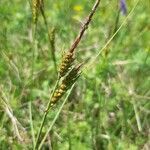Rhizome stoloniferous. Culms laxly tufted, 50-100 cm tall, obtusely trigonous, stiff, slightly scabrous on upper part, with red-brown and bladeless sheaths at base, sheaths later splitting into reticulate fibers. Leaves shorter than or nearly equaling culm, blades 1-2 mm wide, involute on margins, slightly plicate, stiff, with transverse septate nodes between veins, rather long sheathed. Involucral bracts leafy, linear, nearly equaling or slightly longer than inflorescence, lower involucral bracts up to 5 mm sheathed, upper involucral bracts nearly not sheathed. Spikes 3-5; terminal 1-3 spikes male, approximate, linear-cylindric, 2-3 cm, subsessile; remaining spikes female, remote, ovate or oblong-cylindric, 1.5-3 cm, 5-6 mm thick, densely many flowered, shortly pedunculate, upper ones subsessile. Female glumes brown or red-brown laterally, green at middle, oblong-ovate or lanceolate, 4.5-5 mm, membranous, 3-veined, apex acuminate, mucronate. Utricles yellow-green, obliquely patent, slightly shorter than or nearly equaling glume, ovate or oblong-ovate, slightly inflated trigonous, 4-5 mm, leathery, densely brownish gray tomentose, indistinctly veined, base obtusely rounded, apex gradually narrowed to a slightly broad and short beak, orifice slightly recurved 2-toothed. Nutlets rather tightly enveloped, obovate, trigonous, ca. 2 mm, base shortly stipitate; style short, usually curved, base not thickened; stigmas 3. Fl. and fr. Jun-Jul.
More
Plants colonial; rhizomes long-creeping. Culms lateral, trigonous, 40–120 cm, smooth or nearly so. Leaves: basal sheaths reddish purple, fibrillose, bladeless, apex of inner band glabrous; ligules 1–2.5(–3.5) mm; blades gray-green, proximal portion of blade involute or gutter-shaped, becoming narrowly triangular-channeled, blades of vegetative shoots prolonged to curled, filiform tip, midveins of blades and proximal bracts low and rounded, forming inconspicuous keel, 0.7–2(–2.2) mm, glabrous. Inflorescences 6–20 cm; peduncles of terminal spikes (0.8–)2–9 cm; proximal 1–2(–3) spikes pistillate, ascending; distal spikes erect; terminal 1–3 spikes staminate. Pistillate scales lanceolate to ovate, apex acute to acuminate-awned, glabrous or, often, ciliate or finely scabrous-margined apically. Perigynia ascending, veins esentially concealed, broadly ellipsoid, 3–4.3 × 1.5–2.2 mm, densely pubescent, obscuring cellular details and veination; beak 0.5–1.1 mm, firm, bidentulate, teeth straight, 0.2–0.7 mm. 2n = 56.
Much like no. 168 [Carex pellita Willd.], differing most prominently in lvs, these permanently folded along the midrib and tending to appear subterete, only 1–1.5(–2) mm wide as folded; perigynia 2.8–4.3 mm; 2n=56. Bogs, marginal sedge-mats, and shallow water; circumboreal, s. in Amer. to N.J., W.Va., Io., and Wash. (C. lanuginosa) The Amer. plants have been called var. americana Fernald
A dominant plant of boreal wetlands, often forming huge stands, growing in sedge meadows, fens, bogs, lakeshores, stream banks, usually in very wet sites and sometimes forming floating mats; at elevations up to 1,300 metres.


